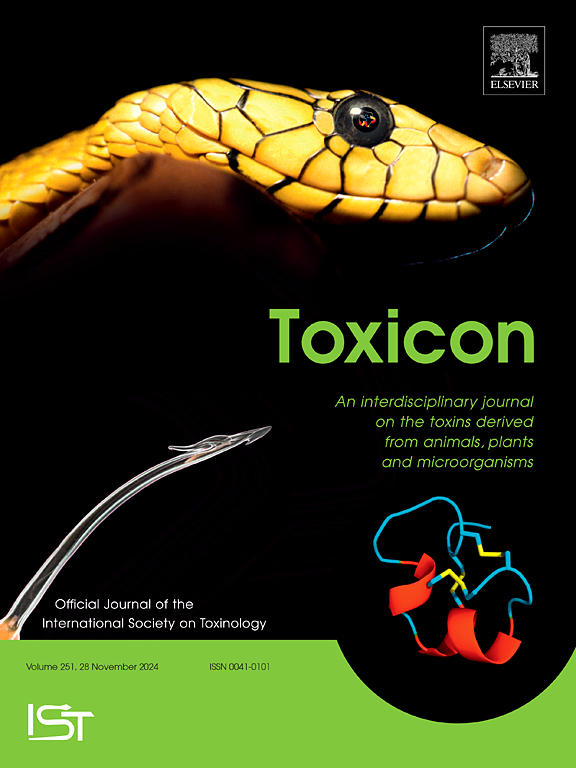Integrating postsynaptic morphology and dynamics to evaluate neuromuscular synapse status: Insights from α-bungarotoxin
IF 2.6
4区 医学
Q2 PHARMACOLOGY & PHARMACY
引用次数: 0
Abstract
The neuromuscular junction (NMJ) is a crucial peripheral synapse that controls muscle contraction. It consists of a presynaptic motor terminal, a postsynaptic muscle domain, and associated cells, such as terminal Schwann cells and kranocytes. Its larger size compared to central synapses has allowed detailed analyses of NMJ morphology that have been widely used as a reliable parameter of synaptic formation, maturation, function, and decline. Due to its high affinity for postsynaptic acetylcholine receptors (AChRs), the snake venom-derived α-bungarotoxin (BTX) has been pivotal in advancing our understanding of NMJ organization, enabling a detailed mapping of postsynaptic morphologies associated to distinct functional outcomes. Although certain morphological features are often associated with NMJ worsening, some of these cellular changes also occur in biological contexts where synaptic function remains intact. In this review, we draw on previous studies and our recent findings using BTX-based pulse-chase assays to suggest that combining morphological analyses with assessments of postsynaptic stability offers a more comprehensive understanding of NMJ function and regenerative potential. We propose that integrating diverse BTX-based tools into studies of NMJ morphology and stability will provide particularly valuable insights in contexts such as aging, injury, and neuromuscular diseases, where these combined parameters may serve as robust predictors of functional outcomes.

整合突触后形态学和动力学来评估神经肌肉突触状态:来自α-虫毒的见解
神经肌肉连接(NMJ)是控制肌肉收缩的关键外周突触。它由突触前运动末端、突触后肌肉区域和相关细胞(如末端雪旺细胞和克拉细胞)组成。与中枢突触相比,它的体积更大,可以对NMJ形态进行详细的分析,NMJ形态被广泛用作突触形成、成熟、功能和衰退的可靠参数。由于其对突触后乙酰胆碱受体(achr)的高亲和力,蛇毒衍生的α-邦加罗毒素(BTX)在促进我们对NMJ组织的理解方面发挥了关键作用,能够详细绘制与不同功能结果相关的突触后形态。尽管某些形态学特征通常与NMJ恶化有关,但这些细胞变化中的一些也发生在突触功能保持完整的生物学背景下。在这篇综述中,我们借鉴了之前的研究和我们最近使用基于btx的脉冲追踪分析的发现,表明将形态学分析与突触后稳定性评估相结合可以更全面地了解NMJ的功能和再生潜力。我们建议,将各种基于btx的工具整合到NMJ形态学和稳定性的研究中,将为衰老、损伤和神经肌肉疾病等情况提供特别有价值的见解,在这些情况下,这些组合参数可以作为功能结果的可靠预测因子。
本文章由计算机程序翻译,如有差异,请以英文原文为准。
求助全文
约1分钟内获得全文
求助全文
来源期刊

Toxicon
医学-毒理学
CiteScore
4.80
自引率
10.70%
发文量
358
审稿时长
68 days
期刊介绍:
Toxicon has an open access mirror Toxicon: X, sharing the same aims and scope, editorial team, submission system and rigorous peer review. An introductory offer Toxicon: X - full waiver of the Open Access fee.
Toxicon''s "aims and scope" are to publish:
-articles containing the results of original research on problems related to toxins derived from animals, plants and microorganisms
-papers on novel findings related to the chemical, pharmacological, toxicological, and immunological properties of natural toxins
-molecular biological studies of toxins and other genes from poisonous and venomous organisms that advance understanding of the role or function of toxins
-clinical observations on poisoning and envenoming where a new therapeutic principle has been proposed or a decidedly superior clinical result has been obtained.
-material on the use of toxins as tools in studying biological processes and material on subjects related to venom and antivenom problems.
-articles on the translational application of toxins, for example as drugs and insecticides
-epidemiological studies on envenoming or poisoning, so long as they highlight a previously unrecognised medical problem or provide insight into the prevention or medical treatment of envenoming or poisoning. Retrospective surveys of hospital records, especially those lacking species identification, will not be considered for publication. Properly designed prospective community-based surveys are strongly encouraged.
-articles describing well-known activities of venoms, such as antibacterial, anticancer, and analgesic activities of arachnid venoms, without any attempt to define the mechanism of action or purify the active component, will not be considered for publication in Toxicon.
-review articles on problems related to toxinology.
To encourage the exchange of ideas, sections of the journal may be devoted to Short Communications, Letters to the Editor and activities of the affiliated societies.
 求助内容:
求助内容: 应助结果提醒方式:
应助结果提醒方式:


